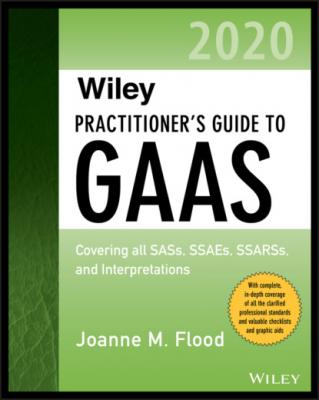Wiley Practitioner's Guide to GAAS 2020. Joanne M. Flood
Читать онлайн.| Название | Wiley Practitioner's Guide to GAAS 2020 |
|---|---|
| Автор произведения | Joanne M. Flood |
| Жанр | Бухучет, налогообложение, аудит |
| Серия | |
| Издательство | Бухучет, налогообложение, аудит |
| Год выпуска | 0 |
| isbn | 9781119596035 |
7 AU-C 260 The Auditor’s Communication with Those Charged with Governance
Objectives of AU-C Section 260
Qualitative Aspects of Accounting Practices
SCOPE
AU-C 260 provides guidance on the auditor’s responsibility to communicate with those charged with governance matters related to the financial statement audit that are, in the auditor’s professional judgment, significant and relevant to the responsibilities of those charged with governance in overseeing the financial reporting process. Note that AU-C 260 does not apply to managers unless they also have a role in governance. (AU-C 260.01) This section may also be adopted and applied to audits of other historical financial information when those charged with governance oversee the preparation and fair presentation of that information. (AU-C 260.02) Certain matters should be communicated in each audit (as described below); however, the auditor is not required to perform procedures specifically to identify these matters.
DEFINITIONS OF TERMS
Source: AU-C 260.06. For definitions related to this standard, see Appendix A, “Definitions of Terms”: Management, Those charged with governance.
OBJECTIVES OF AU-C SECTION 260
The objectives of the auditor are to:
1 communicate clearly with those charged with governance the responsibilities of the auditor regarding the financial statement audit and an overview of the planned scope and timing of the audit.
2 obtain from those charged with governance information relevant to the audit.
3 provide those charged with governance with timely observations arising from the audit that are significant and relevant to their responsibility to oversee the financial reporting process.
4 promote effective two-way communication between the auditor and those charged with governance.
(AU-C Section 260.05)
REQUIREMENTS
Those Charged with Governance
AU-C 260.09 and AU-C 206.A6–.A9 provide some guidance on how the auditor should determine which persons or bodies are “those charged with governance” (see “Definitions of Terms”). Governance structures vary by entity; however, in most entities, governance is the collective responsibility of a governing body, such as a board of directors, a supervisory board, partners, proprietors, a committee of management, trustees, or equivalent. In some entities, one person, such as the owner-manager, may be the sole person charged with governance of the entity.
When “those charged with governance” are not clearly identifiable, the auditor and the engaging party should agree on the person(s) with whom the auditor will communicate. In those situations where the entity’s governance structure includes subgroups (e.g., an audit committee), the auditor also should evaluate whether communication with a subgroup is sufficient.
Matters to Be Communicated
The auditor should communicate with those charged with governance:
The auditor’s responsibility under generally accepted auditing standards, that is, forming and expressing an opinion on statements prepared by management with oversight by those charged with governance in accordance with the applicable financial reporting framework.
The fact that the audit of the financial statements does not relieve management or those charged with governance of their responsibilities.
An overview of the planned scope and timing of the audit.
Significant findings from the audit.
(AU-C 260.10–.12)
The auditor may communicate matters such as:
The auditor is responsible for performing the audit in accordance with GAAS.
An audit is designed to obtain reasonable, not absolute, assurance.
An audit includes consideration of internal control as a basis for designing audit procedures, but not for expressing an opinion on the effectiveness of internal control over financial reporting.
The auditor is responsible for communicating significant matters related to the audit that are relevant to the responsibilities of those charged with governance.
The auditor is responsible for communicating particular matters required by laws or regulations, agreement with the entity, or additional requirements applicable to the engagement.
(AU-C 260.A13)
Overview of the Planned Scope and Timing of the Audit
The auditor should communicate an overview of the planned scope and timing of the audit. To meet that general requirement, the auditor may communicate matters such as the following:
How the auditor proposes to address the significant risks of material misstatement.
The auditor’s approach to internal control.
The application of materiality in planning and executing the audit.
Where the entity has an internal audit function and the internal auditors can work together in a constructive manner, the extent to which the auditor will use internal auditors.
The views of those charged with governance about:The appropriate person(s) in the entity’s governance structure with whom to communicateThe allocation of responsibilities between those charged with governance and managementThe entity’s objectives and strategies, and the related business risks that may result in material misstatementsMatters those charged with governance consider to warrant particular attention during the audit, and any areas where they request additional procedures to be undertakenSignificant communications with regulatorsOther matters those charged with governance believe are relevant to the audit of the financial statements
The attitudes, awareness, and actions of those charged with governance concerning
